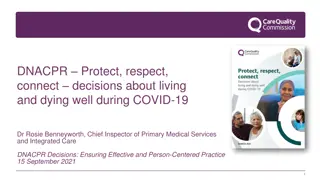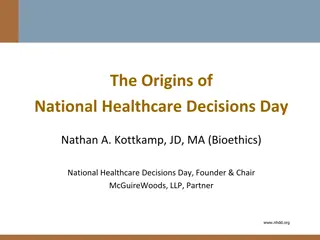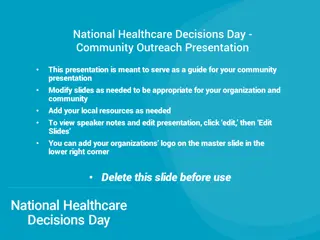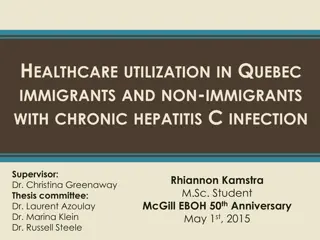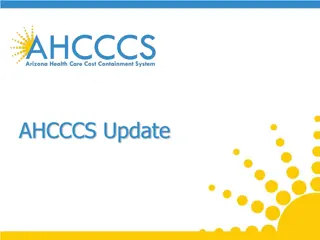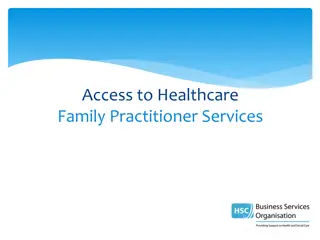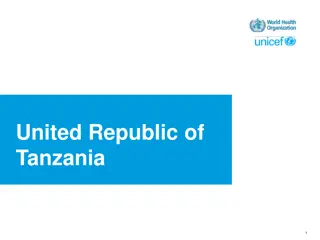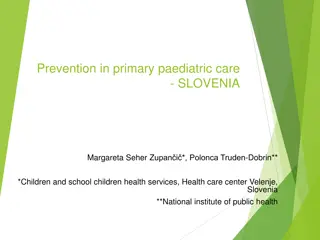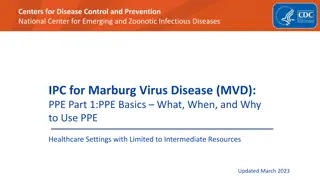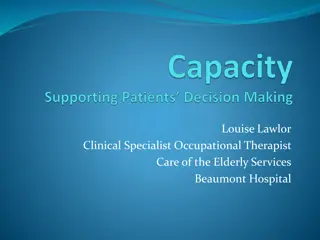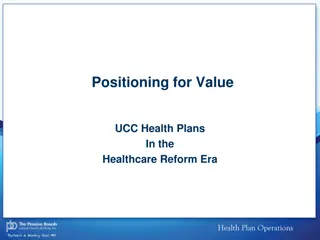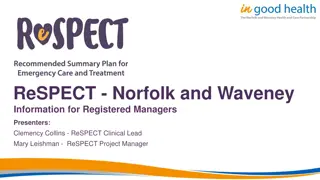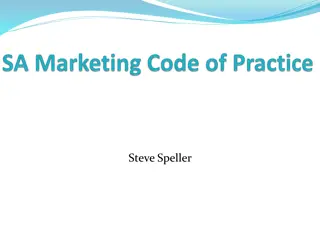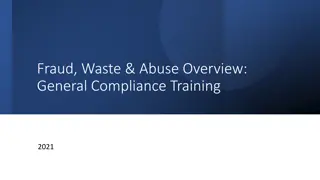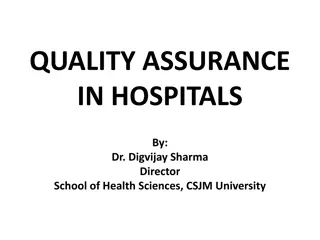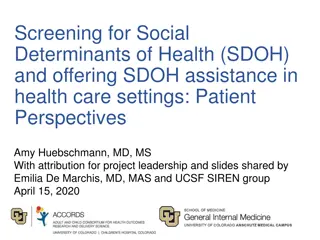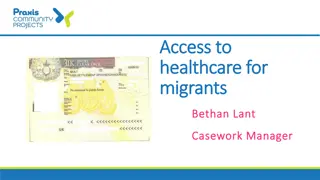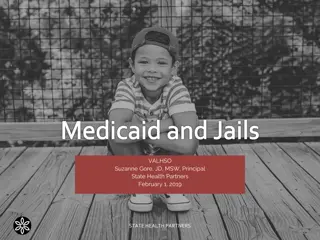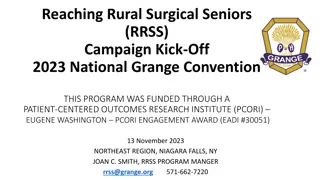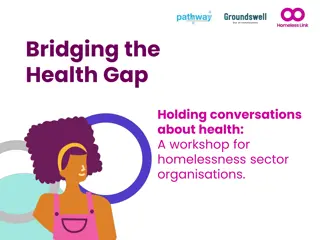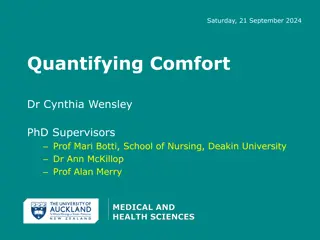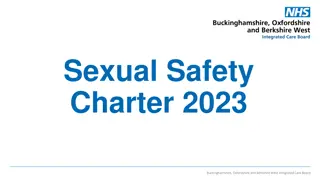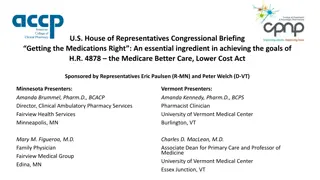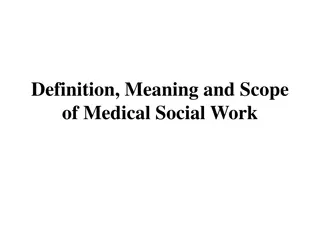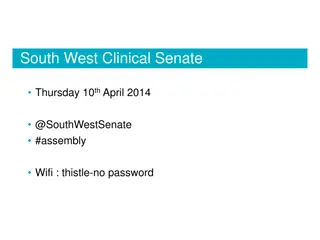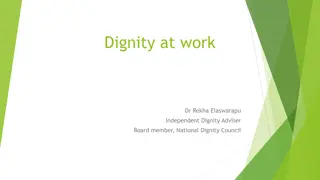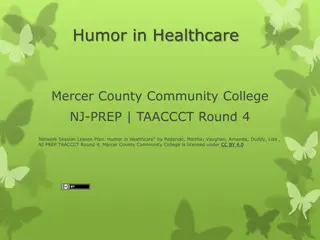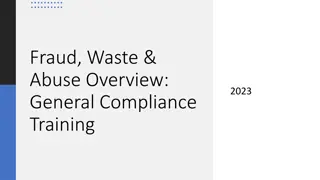Understanding the Importance of DNACPR Decisions in Healthcare
DNACPR decisions play a crucial role in healthcare, with implications for patients, families, and medical professionals. This content explores the significance of DNACPR, the complexities surrounding its implementation, and the impact on patient care and outcomes. It highlights common misconceptions, ethical considerations, challenges, and real-life scenarios related to DNACPR decisions.
Download Presentation

Please find below an Image/Link to download the presentation.
The content on the website is provided AS IS for your information and personal use only. It may not be sold, licensed, or shared on other websites without obtaining consent from the author. Download presentation by click this link. If you encounter any issues during the download, it is possible that the publisher has removed the file from their server.
E N D
Presentation Transcript
DNACPR Decisions Dr Jim Crawfurd EM Consultant and Resus Committee Chair ACCS Regional Training Day 13thJan 2016
Why? Why is it so important to some patients and familes? Why is it actually not very important at all?
DGH Annual Figures (Approx) 60,000 admissions per year (plus OPA and A&E) 1,500 deaths (ie cardiac arrests) 100 attempted resuscitations 20 successful resuscitations 6 DNACPR related complaints
Issues raised in Complaints Patient challenging decision Patient upset at finding form on discharge Family upset at finding form on discharge (several) Family upset at finding about decision at/ after death (several) Family upset at not being involved and questioning whether patient had capacity (several) Family felt discussion had distressed patient Patient found discussion distressing Another patient felt uncomfortable hearing it being discussed with patient in next bed Family upset that patient with DNACPR directive had been resuscitated
Playing God Cardiac arrest occurs as part of the natural process of every single death I think we are more guilty of playing god by trying to reverse that process than by allowing it to happen
Wanting to Stay Alive Public perception that CPR has a good chance of success and that quality of life will be worthwhile after successful resuscitation In reality outcomes are generally poor I have never seen anyone come out of cardiac arrest healthier than they were before it
The Big Misconception TV dramas 75% ROSC with 66% survival to discharge with full functional recovery Newspapers over-report success stories Patient estimates 81% of elderly patients in US study believed chance of survival to discharge >50% 25% believed chance was >90%
The Facts Approx 40% ROSC and 20% survival to discharge Many will survive in reasonable condition Majority of survivors are younger and have primary cardiac disease and shockable rhythm Survival to discharge in elderly, frail, gradually deteriorating patients with non-shockable rhythm is virtually zero
REMEMBER... These figures are for patients in whom CPR was felt to be appropriate Figures will be considerably lower for those who are more frail/ have more co-morbidity in whom clinicians feel CPR would not be appropriate
I could have been given the chance to say goodbye Often the relatives feel we should keep the patient alive for long enough to allow them to say goodbye This is of no benefit to the patient But if the patient is already dying then perhaps we can t do anything for them, but should do what we can for the family
Do you want us to let you die? Question nurses on home visits are told to ask elderly patients they have just met Patients asked via form if they would agree to a 'do not resuscitate order'
Let you Die DNACPR is just that it is a decision not to try to bring someone back from the dead It MUST NOT have any bearing on other aspects of care It is not about letting people die, it is about letting them die with dignity when death is inevitable
Resuscitate First, Ask Questions Later Presumption is in favour of CPR unless clear, written, valid DNACPR instruction is available No system is 100% perfect If in doubt, it is less damaging to carry out CPR on someone who had a DNACPR order in place than to NOT carry out CPR on someone who didn t have one
Tracey vs Addenbrookes 2014 Several headlines were inaccurate Judge upheld that it is a clinical decision and that the courts should not be guiding medical decision making Ruling was very much in keeping with existing guidance Legal duty to inform patient who has capacity unless it would cause actual harm
Winspear vs Sunderland November 2015 28 yr old patient with severe Cerebral Palsy Admitted with severe pneumonia DNACPR decision made at 3am by medical reg Didn t want to disturb mother at 3am Mother very upset Judge ruled no decision without at least attempting to discuss with family
Concern over: Poor legibility Empty boxes Failure to communicate or follow up on communication attempts To be discussed with family... Family not available ....
Why make any decisions? Patient dignity and quality of life (and death) Resources Cardiac arrest team ICU Patient choice Family wellbeing Staff wellbeing National Guidance
DNACPR Policy Key Points Patient Centred Presumption in favour of CPR if no decision in place Responsibility lies with Consultant Responsibility to identify: Patients in whom CPR would not be appropriate Patients who would not want CPR Decision is ONLY about CPR must not affect other aspects of care NCEPOD recommend decisions to be made for all patients on admission or first consultant review Good Documentation and Communication are Vital
For CPR Where clinical staff feel CPR would be appropriate, there is no requirement to discuss with patient or family If patient wishes to discuss it, then staff should engage and provide adequate information If a competent patient declares a wish NOT to have CPR then this should be respected
Where CPR would not succeed Definition: There is no realistic prospect of restoring heartbeat and breathing for any sustainable period Not appropriate to seek patient s/ relatives views as this is a clinically futile treatment which will not be offered Legal obligation to inform patient (if they have capacity) of decision unless would cause actual harm Legal obligation to inform family/ those close to patient if patient lacks capacity
Best Interests decisions Where CPR might succeed but may leave the patient with unacceptable quality of life Only the patient can decide what they would see as acceptable quality of life so discussion is mandatory Patient s decision should be respected
Best Interests decisions If patient lacks capacity then decision MUST be discussed with relatives or those close to the patient Legally appointed Power of Attorney can make decision for the patient If no POA appointed then role of family is purely to ADVISE doctors on what they think patient would want Clinicians must then make decision and inform relatives IMCA if no relatives/close friends
Advance Directives Where a valid advance directive exists and includes a refusal of CPR applicable to the current circumstance then that refusal should be respected A patient cannot insist on CPR where it would be futile (ie. CPR would not succeed)
Communicating with Relatives of Patients with Capacity Several complaints have related to elderly patients who were deemed to have capacity but family felt they should have been informed/ involved Encourage patient to involve family or inform family of decision Clinical staff should offer to inform family if patient would prefer Document this on DNACPR form Standard confidentiality rules apply
When, who and how When is the right time to discuss CPR? Who should discuss it? How should it be brought up?
In an ideal world...? As we gradually and gracefully approach the end of our life With a trusted family GP or consultant As part of a gradual process No urgency All the information we want Our views respected As part of the bigger picture
In a non-ideal world... On admission to hospital? For some? For all? By whom? On post-take ward round? Too busy? Too late? Relatives often not present Only when moribund? (like in the bad old days ) Too late (patient choice)? What if too sudden?
Do I need to make a decision right now? Low Risk of Cardiac Arrest High Risk of Cardiac Arrest Urgently escalate to try to prevent the arrest ITU? For CPR Need urgent decision explore with patient/family, escalate to seniors, agree a management plan CPR For CPR appropriate CPR not appropriate No need for urgent decision explore if comfortable NO HURRY!
How to approach? Depends on situation: 23yr old fit and well, acute appendicitis 45yr old fit and well, acute severe pneumonia 83yr old multiple co-morbidities, mild cellulitis 88yr old multiple co-morbidities, severe pneumonia
Who should approach? Anyone with adequate communication skills can explore patient/relatives views Decision needs to be made by someone with clinical understanding of likely outcome The challenge: Juniors: adequate time, but sometimes not enough confidence/knowledge Seniors: Adequate confidence/knowledge, not enough time
Disagreements Disagreements over DNACPR status are rare when good communication takes place If disagreement cannot be resolved then a second opinion should be offered DNACPR decision is SUSPENDED pending the second opinion (local policy at my trust) Second opinion should be from senior clinician with good understanding of the issues (Resus committee members, ITU consultants etc)
My own view Increasingly patient-centred Don t force it or rush it Maybe it should be up to the patient So long as fully informed of risks Review as condition progresses Not binding after loss of capacity Ethically different when family are insisting? Focus on the easy ones not the hard ones
Suspending and Voiding It may be appropriate to temporarily suspend a DNACPR decision, eg. During a surgical procedure This should be clearly documented on form, as should decision to reinstate DNACPR directive If decision is revoked then mark form clearly with VOID or Cancelled in large letters diagonally across form AAGBI guidance
Discharge Decisions Historically decisions were always voided on discharge This is no longer always appropriate If DNACPR directive is to remain in place on discharge then: Patient or Family MUST be aware of and in agreement with decision East of England DNACPR form to be completed and copy given to patient GP, receiving institution and transfer personnel must be informed
Readmission DNACPR forms will be in hospital records but decision may have been overturned by GP in the meantime If a valid form accompanies patient then safe to assume that DNACPR decision stands If not, then you MUST confirm decision with patient/ relatives and complete new form
The Future is here already... Putting DNACPR in the right context UFTO, CAP etc Focus on what we WILL DO not what we won t Consider other limitations, not just CPR ITU, NIV, dialysis, PEG feeding etc Resus Council (UK) Form due out soon! BUT... A new form does not, by itself, improve practice: Training, guidance, information packs, introduce slowly
The Bottom Line Communication Communication Communication
References https://www.resus.org.uk Resus Council (UK) Website Decisions relating to CPR guidance Decisions relating to CPR new statement Emergency Care and Treatment Plan consultation just opened http://www.ncepod.org.uk/2012cap.htm NCEPOD statement on CPR decision making http://www.aagbi.org/sites/default/files/dnar_09 _0.pdf AAGBI guidance for peri-operative management of patients who have a DNACPR decision in place


